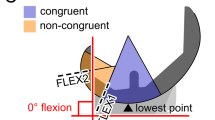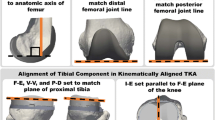Abstract
Purpose
Accurate soft tissue balance must be achieved to improve functional outcome after total knee arthroplasty (TKA). Sensor-integrated tibial trials have been introduced that allow real-time measurement of tibiofemoral kinematics during TKA. This study examined the interplay between tibiofemoral force and laxity, under defined intraoperative conditions, so as to quantify the kinematic behaviour of the CR femoral single-radius knee.
Methods
TKA was undertaken in eight loaded cadaveric specimens. Computer navigation in combination with sensor data defined laxity and tibiofemoral contact force, respectively, during manual laxity testing. Fixed-effect linear modelling allowed quantification of the effect for flexion angle, direction of movement and TKA implantation upon the knee.
Results
An inverse relationship between laxity and contact force was demonstrated. With flexion, laxity increased as contact force decreased under manual stress. Change in laxity was significant beyond 30° for coronal plane laxity and beyond 60° for rotatory laxity (p < 0.01). Rotational stress in mid-flexion demonstrated the greatest mismatch in inter-compartmental forces. Contact point position over the tibial sensor demonstrated paradoxical roll-forward with knee flexion.
Conclusion
Traditional balancing techniques may not reliably equate to uniform laxity or contact forces across the tibiofemoral joint through a range of flexion and argue for the role of per-operative sensor use to aid final balancing of the knee.






Similar content being viewed by others
References
Atwood SA, Currier JH, Mayor MB (2008) Clinical wear measurement on low contact stress rotating platform knee bearings. J Arthroplasty 23:431–440
Baker P, Rushton S, Jameson SS, Reed M, Gregg P, Deehan D (2013) Patient satisfaction with total knee replacement cannot be predicted from pre-operative variables alone: a cohort study from the National Joint Registry for England and Wales. Bone Jt J 95B(10):1359–1365
Banks SA, Markovich GD, Hodge WA (1997) In vivo kinematics of cruciate-retaining and -substituting knee arthroplasties. J Arthroplasty 12:297–304
Barrack RL, Schrader T, Bertot AJ, Wolfe MW, Myers L (2001) Component rotation and anterior knee pain after total knee arthroplasty. Clin Orthop Relat Res 392:46–55
Blunn GW, Walker PS, Joshi A, Hardinge K (1991) The dominance of cyclic sliding in producing wear in total knee replacements. Clin Orthop Relat Res 273:253–260
Booth RE (2002) Tensioners: essential for accurate performance of TKA. Orthopedics 26:962–964
Dalury DF, Pomeroy DL, Gorab RS, Adams MJ (2013) Why are total knee arthroplasties being revised? J Arthroplasty 28:120–121
Dennis DA, Komistek RD, Colwell CE Jr, Ranawat CS, Scott RD, Thornhill TS, Lapp MA (1998) In vivo anteroposterior femorotibial translation of total knee arthroplasty: a multi-center analysis. Clin Orthop Relat Res 356:47–57
Dennis DA, Komistek RD, Mahfouz MR, Haas BD, Stiehl JB (2003) Multicenter determination of in vivo kinematics after total knee arthroplasty. Clin Orthop Relat Res 416:37–57
D’Lima DD, Patil S, Steklov N, Colwell CW Jr (2011) The 2011 ABJS Nicolas Andry Award: ‘Lab’-in-a-knee: in vivo knee forces, kinematics, and contact analysis. Clin Orthop Relat Res 469:2953–2970
Elfring R, de la Fuebte M, Radermacher K (2010) Assessment of optical localizer accuracy for computer aided surgery systems. Comput Aided Surg 15:1–12
Freeman MA, Pinskerova V (2003) The movement of the knee studied by magnetic resonance imaging. Clin Orthop Relat Res 410:35–43
Fregly BJ, Sawyer WG, Harman MK, Banks SA (2005) Computational wear prediction of a total knee replacement from in vivo kinematics. J Biomech 38:305–314
Ghosh KM, Blain AP, Longstaff L, Rushton S, Amis AA, Deehan DJ (2014) Can we define envelope of laxity during navigated knee arthroplasty? Knee Surg Sports Traumatol Arthrosc 22:1736–1743
Ghosh KM, Manning WA, Blain Rushton SP, Longstaff L, Amis A, Deehan DJ (2015) The influence of increasing construct constraint in the presence of posterolateral deficiency at knee replacement: a biomechanical study. J Orthop Res. doi:10.1002/jor.23026
Griffin FM, Insall JN, Scuderi GR (2000) Accuracy of soft tissue balancing in total knee arthroplasty. J Arthroplasty 15:970–973
Grood ES, Suntay WJ (1983) A joint coordinate system for the clinical description of three-dimensional motions: application to the knee. J Biomech Eng 105:136–144
Gustke KA (2014) Soft-tissue and alignment correction: the use of smart trials in total knee replacement. Bone Jt J 96B:78–83
Gustke KA, Golladay GJ, Roche MW, Jerry GJ, Elson LC, Anderson CR (2014) A new method for defining balance: promising short-term clinical outcomes of sensor-guided TKA. J Arthroplasty 29:955–960
Halder A, Kutzner I, Graichen F, Heinlein B, Beier A, Bergman G (2012) Influence of limb alignment on mediolateral loading in total knee replacement: in vivo measurements in five patients. J Bone Jt Surg Am 94(11):1023–1029
Halewood C, Risebury M, Thomas NP, Amis AA (2014) Kinematic behaviour and soft tissue management in guided motion total knee replacement. Knee Surg Sports Traumatol Arthrosc 22(12):3074–3082
Hananouchi T, Yamamoto K, Ando W, Fudo K, Ohzono K (2012) The intraoperative gap difference (flexion gap minus extension gap) is altered by insertion of the trial femoral component. Knee 19(5):601–605
Hetalmish BM, Khan MM, Simunovic N, Al-Harbi HH, Bhandari M, Zalzal PK (2012) Meta-analysis of navigation versus conventional total knee arthroplasty. J Arthroplasty 27(6):1177–1182
Hunt NC, Ghosh KM, Blain AP, Athwal KK, Rushton SP, Amis AA, Longstaff LM, Deehan DJ (2014) How does laxity after single radius total knee arthroplasty compare with the native knee. J Orthop Res 32(9):1208–1213
Kurtz SM, Ong KL, Lau E, Widmer M, Maravic M, Gómez-Barrena E, de Pina Mde F, Manno V, Torre M, Walter WL, de Steiger R, Geesink RG, Peltola M, Röder C (2011) International survey of primary and revision total knee replacement. Int Orthop 35(12):1783–1789
Matsuda Y, Ishii Y, Noguchi H, Ishii R (2005) Varus–valgus balance and range of movement after total knee arthroplasty. J Bone Jt Surg Br 87:804–808
Miller EJ, Pagnano MW, Kaufman KR (2014) Tibiofemoral alignment in posterior stabilized total knee arthroplasty: static alignment does not predict dynamic tibial plateau loading. J Orthop Res 32:1068–1074
Morgan H, Battista V, Leopold SS (2005) Constraint in primary total knee arthroplasty. J Am Acad Orthop Surg 13:515–524
Mündermann A, Dyrby CO, D’Lima DD, Colwell CW Jr, Andriacchi TP (2008) In vivo knee loading characteristics during activities of daily living as measured by an instrumented total knee replacement. J Orthop Res 26(9):1167–1172
Nicoll D, Rowley DI (2010) Internal rotational error of the tibial component is a major cause of pain after total knee replacement. J Bone Jt Surg Br 92:1238–1244
Ostermeier S, Schlomach C, Hurschler C, Windhagen H, Stukenborg-Colsman C (2006) Dynamic in vitro measurement of posterior cruciate ligament load and tibiofemoral stress after TKA in dependence on tibiofemoral slope. Clin Biomech 21:525–532
Pearle AD, Solomon DJ, Wanich T, Moreau-Gaudry A, Granchi CC, Wiekiewicz TL, Warren RF (2007) Reliability of navigated knee stability examination: a cadaveric evaluation. Am J Sports Med 35:1315–1320
Pinheiro JC, Bates DM (2000) Mixed-effects models in S and S-PLUS. Springer, New York
Singerman R, Dean JC, Pagan HD, Goldberg VM (1996) Decreased posterior tibial slope increases strain in the posterior cruciate ligament following total knee arthroplasty. J Arthroplasty 11:99–103
Stoddard JE, Deehan DJ, Bull AM, McCaskie AW, Amis AA (2013) The kinematics and stability of single-radius versus multi-radius femoral components related to mid-range instability after TKA. J Orthop Res 31:53–58
Tardy N, Mouton C, Boisrenoult P, Theisen D, Beaufils P, Seil R (2014) Rotational profile alterations after posterolateral corner reconstruction in multiligament injured knees. Knee Surg Sports Traumatol Arthrosc 22(9):2173–2180
van Jonbergen HP, Reuver JM, Mutsaerts EL, Poolman RW (2014) Determinants of anterior knee pain following total knee replacement: a systematic review. Knee 22:478–499
Victor J, Bellemans J (2006) Physiologic kinematics as a concept for better flexion in TKA. Clin Orthop Relat Res 452:53–58
Walker PS, Meere PA, Bell CP (2014) Effects of surgical variables in balancing of total knee replacements using an instrumented tibial trial. Knee 21:156–161
Whiteside LA (1999) Selective ligament release in total knee arthroplasty of the knee in valgus. Clin Orthop Relat Res 367:130–140
Williams DP, O’Brien S, Doran E, Price AJ, Beard DJ, Murray DW, Beverland DE (2013) Early postoperative predictors of satisfaction following total knee arthroplasty. Knee 20:442–466
Zaffagnini S, Bignozzi S, Saffarini M, Colle F, Sharma B, Kinov PS, Marcacci M, Dejour D (2014) Comparison of stability and kinematics of the natural knee versus a PS TKA with a ‘third condyle’. Knee Surg Sports Traumatol Arthrosc 22:1778–1785
Acknowledgments
Technical support was provided by Phil Jackson and Kate Moyle (Newcastle Surgical Training Centre) and Andrew Bowman (Stryker, UK). Funding for this work was obtained through Newcastle Charitable Trustees and a generous grant from Stryker Europe Research Division. We would like to thank Chris Anderson of Orthosensor for his advice and support.
Author information
Authors and Affiliations
Corresponding author
Rights and permissions
About this article
Cite this article
Manning, W.A., Ghosh, K., Blain, A. et al. Tibiofemoral forces for the native and post-arthroplasty knee: relationship to maximal laxity through a functional arc of motion. Knee Surg Sports Traumatol Arthrosc 25, 1669–1677 (2017). https://doi.org/10.1007/s00167-016-4093-2
Received:
Accepted:
Published:
Issue Date:
DOI: https://doi.org/10.1007/s00167-016-4093-2




